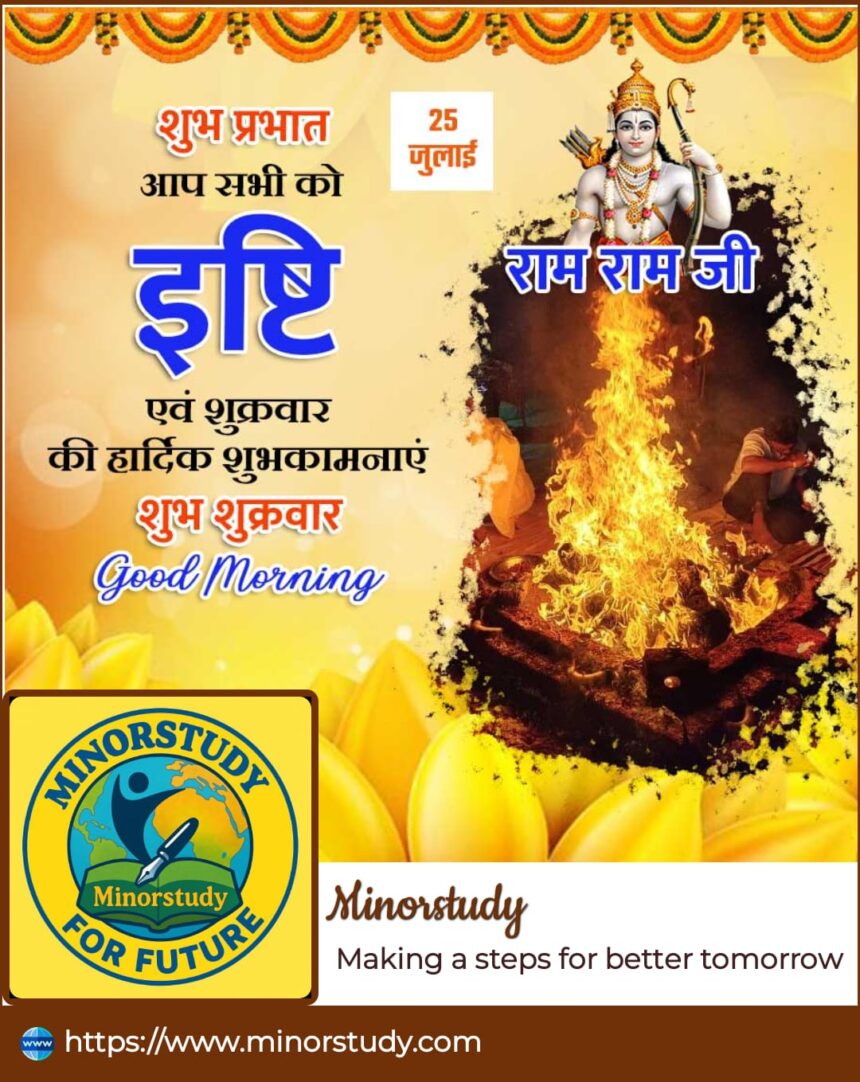🪔 7 Powerful Truths About Ishti – The Forgotten Vedic Ritual That Can Transform Your Life
In the vast ocean of Sanatan Dharma, many rituals have silently faded into obscurity, yet hold profound spiritual and practical significance. One such powerful and forgotten tradition is Ishti (इष्टि)—a sacred offering deeply rooted in the Vedic age. Far more than a ritual, Ishti is a spiritual dialogue between the seeker and the divine, a blend of intention, sacrifice, and gratitude.
- 🌅 What is Ishti?
- 📜 History of Ishti – From Vedas to Vanishing
- 📚 Interesting Facts About Ishti
- 📅 Timeline – Ishti Through the Ages
- ❓ FAQs – Frequently Asked Questions
- Q1: Is Ishti the same as Yajna?
- Q2: Who can perform Ishti?
- Q3: Is there a specific day to perform Ishti?
- Q4: What is offered in an Ishti?
- Q5: Does Ishti still have a place in modern life?
- ✨ Significance of Ishti in Life
- 1. Purification of Intentions
- 2. Connects Us with Natural Forces
- 3. Cultivates Gratitude
- 4. Promotes Harmony and Focus
- 5. Strengthens Family Bonds
- 🕉️ Observance – How Ishti is Performed
- 🌟 7 Reasons Why Ishti Still Matters Today
- 🌸 Heartfelt Wishing for Ishti Observers
- 🔚 Conclusion – Reclaiming the Power of Vedic Intent
In this article, we’ll explore everything about Ishti—its origin, timeline, facts, cultural relevance, FAQs, observance, and its transformative impact on modern life in more than 1200+ words, crafted in a human-friendly and meaningful tone.
🌅 What is Ishti?
The term Ishti comes from the Sanskrit root “Ish” (इष्) meaning to desire or to worship. In the Vedic context, Ishti refers to a ritual offering or sacrifice, particularly in the form of a fire ritual (Yajna), wherein grains, clarified butter (ghee), herbs, and prayers are offered to the deities for fulfillment of specific intentions.
It is not merely religious, but a spiritual declaration of purpose—a personal or collective wish placed before the cosmic forces with humility and faith.
📜 History of Ishti – From Vedas to Vanishing
Rigveda and Yajurveda are full of descriptions of Ishtis performed by kings, sages, and householders.
Ishtis were performed during sunrise or full moons, or before beginning significant tasks—be it a war, a yajna, a journey, or a wedding.
Over time, as formalized temple worship and bhakti movements became more dominant, these Vedic fire offerings dwindled in household life.
However, in some South Indian Agama traditions and among Vedic scholars, the ritual still survives.
Ishti is often performed as a part of Sandhya rituals or Agnihotra even today by Vedic families.
📚 Interesting Facts About Ishti
Ishti is different from Shraddha or other funerary rites; it is a living ritual, done for progress and prosperity.
The offerings made in Ishti are called “Puroḍāśa”—rice cakes or ghee-filled oblations.
Mahabharata and Ramayana both mention kings and rishis doing ishtis before wars or major decisions.
In Pancharatra Agama, Ishti is classified as one of the regular temple services.
Some families still perform monthly or seasonal Ishtis on Purnima (full moon) or Sankranti days.
📅 Timeline – Ishti Through the Ages
| Era | Ishti Practice |
|---|---|
| Vedic Age (1500–500 BCE) | Ishti as daily household and state ritual; performed by kings and commoners alike. |
| Epic Period (500 BCE–0) | Mentioned in Ramayana and Mahabharata as a way to invoke divine blessings. |
| Gupta Period (300–600 CE) | Decline in common practice; continued among Brahmins and Yajurvedins. |
| Medieval Era (600–1500 CE) | Shift to Bhakti rituals; Ishti confined to Vedic scholars. |
| Present Day | Rare, but still observed among orthodox families and revived by Vedic spiritual institutions. |
❓ FAQs – Frequently Asked Questions
Q1: Is Ishti the same as Yajna?
No, Ishti is a type of Yajna—specifically smaller in scale, often personal or seasonal, and directed toward specific desires or life milestones.
Q2: Who can perform Ishti?
Traditionally, Vedic Brahmins or householders with Agni (ritual fire) would perform Ishti. However, with guidance, even spiritually inclined individuals can organize it today with a priest.
Q3: Is there a specific day to perform Ishti?
Ishti can be done on Purnima, Ekadashi, Amavasya, or Sankranti, or any auspicious occasion depending on the intention.
Q4: What is offered in an Ishti?
Offerings include ghee, rice, sesame seeds, herbs, honey, and sacred chants (mantras). The aim is self-purification, harmony, and cosmic alignment.
Q5: Does Ishti still have a place in modern life?
Absolutely. Ishti embodies intention-setting, detachment, and gratitude—universal values crucial for today’s fast-paced world.
✨ Significance of Ishti in Life
1. Purification of Intentions
Every action begins with intention (Sankalpa). Ishti allows purification of that intention through sacred action.
2. Connects Us with Natural Forces
Ishti rituals invoke Agni (fire), Vayu (air), Surya (sun)—symbolizing energy, breath, and consciousness.
3. Cultivates Gratitude
By offering back a portion of what we receive, Ishti nurtures humility and thankfulness—core to human balance.
4. Promotes Harmony and Focus
Rituals like Ishti bring mental peace, reduce chaos, and align our thoughts toward constructive action.
5. Strengthens Family Bonds
Traditionally done with family, Ishti reinforces unity, values, and joint purpose among members.
🕉️ Observance – How Ishti is Performed
Clean environment and sanctified altar with sacred fire (Homa Kund).
Sankalpa (intention setting) by the performer or priest.
Offerings (Ahutis) made into the fire with Vedic mantras.
Recitation of Purusha Sukta, Shanti Path, or Gayatri mantra.
Aarti, Prasad distribution, and charity (Daan) conclude the ritual.
It can be done in homes, temples, or ashrams, especially on Shravan, Kartik, or Pausha months for prosperity, health, and clarity.
🌟 7 Reasons Why Ishti Still Matters Today
| Reason | Impact on Daily Life |
|---|---|
| 1. Ancient Yet Relevant | Helps align intentions with actions. |
| 2. Mental Clarity | Focuses mind during confusion or decision-making. |
| 3. Emotional Release | Acts as a spiritual form of closure or healing. |
| 4. Community & Unity | Brings people together for shared purpose. |
| 5. Discipline & Routine | Instills spiritual rhythm into life. |
| 6. Energy Cleansing | Fire ritual believed to neutralize negativity. |
| 7. Cultural Revival | Preserves Vedic wisdom for future generations. |
🌸 Heartfelt Wishing for Ishti Observers
“May the sacred fire of Ishti burn away your doubts and ignite the light of clarity, health, and spiritual fulfillment in your life.”
“As you perform or reflect on this sacred Vedic tradition, may your intentions be pure, your actions aligned, and your life elevated.”
🔚 Conclusion – Reclaiming the Power of Vedic Intent
In a world full of distractions, stress, and aimlessness, the Vedic ritual of Ishti offers us a still, sacred space to focus, cleanse, and connect. It reminds us that life is not only about action, but also about intention.
While it may seem like a forgotten flame, Ishti’s relevance is eternal. It is a timeless tool for spiritual wellness, family unity, mental clarity, and cultural pride. Whether you perform it traditionally or reflect upon it symbolically—it holds the power to transform your inner world.
So next time you’re at a crossroads, or celebrating a milestone—light a lamp, chant a prayer, or offer gratitude—invoke the spirit of Ishti, and let your actions resonate with the divine.








